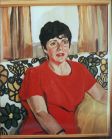The Clearances: From Rùm To Nova Scotia Poem by Sheena Blackhall
The Clearances: From Rùm To Nova Scotia
In 1621, William Alexander,1st Earl of Stirling, was granted permission by King James VI of Scotland and I of England to establish a settlement in Acadian Canada. James VI and I was the son of Mary Queen of Scots. He became King of England after the death of Queen Elizabeth I.The new settlement was called 'Nova Scotia' - New Scotland.
Rùm, is an island of the Inner Hebrides,
In the district of Lochaber, Scotland
It has been inhabited since the 8th millennium
Held by various clans down the centuries
Now it is now an important study site
For the red deer, the white-tailed sea eagle.
Seagoing Hebrideans had taboos about naming islands
In the case of Rùm, use of the name was forbidden,
It was called Rìoghachd na Forraiste Fiadhaich—
The kingdom of the wild forest
Once there were alder, hazel and willow trees
Before man left it shorn like a bald head
Columba established Christianity here, with
Beccan of Rùm, a monk from sacred Iona
Who wrote of Columba:
In scores of curraghs with an army of wretches
He crossed the long-haired sea.
He crossed the wave-strewn wild region,
Foam flecked, seal-filled, savage, bounding,
Seething, white-tipped, pleasing, doleful.
Once, there were 9 busy villages
Here, black cattle were raised to export to the mainland,
Goats were kept, their hair was sent to Glasgow
Made into wigs for export to America.
Shipwrecks provided wine
Kelp was sold, a little barley grown
The mountain goats ranged over the soaring hills
Of Rùm Cuillin, hills with Old Norse and Gaelic names
Askival, the mountain of the ash trees
Ainshval -the mountain of the strongholds
Trollavil, the mountain of the trolls)
Sgurr nan Gillean, the peak of the young men
Orval, Sròn an t-Saighdeir
Bloodstone Hill in the west.
Now, there is no indigenous population
Residents are employees of Scottish Natural Heritage
Their families, researchers, a school teacher
There are artists and crafters, three newly created crofts
Sheep, pigs and poultry, mountain goats and ponies
No church or pub,
But a village hall a tiny primary school.
A shop, post office and a summer teashop
You can walk to the A'Bhrideanach peninsula,
Wreck Bay, and the cliffs ofSgorr Reidh
Ah then, the Clearances, the Rùmachs, the people,
Evicted by the laird and his kinsman, Lachlan Maclean
In1825four hundred and fifty people
Given one year's notice to quit
Their homes handed over to bleating blackface sheep
In July the following year, three hundredboarded
Two overcrowded ships bound for Cape Breton
MacLeans, MacKays, MacKinnons and MacPhadens
McKinnon from Rùm was the first settler by Kinloch
On the Northwestern side of Inverness County, Cape Breton
Two brothers, Donald and Allan McLean,
Were the first settlers of Beech Hill, Inverness County in 1826.
In 1827, giving evidence to a government committee,
An agent of the laird was asked
‘And were the people willing to go? '
‘Some of them, ' came the reply,
‘Others were not very willing,
They did not like to leave the land of their ancestors'
An eyewitness, a local shepherd, told them
‘The people of the island were carried off in one mass, for ever,
from the sea-girt spot where they were born and bred...
The wild outcries of the men and heart-breaking wails of the women
and children filled all the air between the mountainous shore of the bay'
In 1845, bankrupt,the MacLean laird sold the island
Now wild goat graze the braes of the western sea cliffs
The native cattle roam the lands round Harris
Greylag Geese and cormorants haunt the shores
Manx shearwaters breed in the Cuillin Hills
White-tailed sea eagles soar in the pearly clouds
Brown trout, eels and stickleback swim the streams,
Salmon run in the sparkling Kinloch River
Damson fly, dragonfly, beetle, butterfly, moth
Flit over lochans, where swarms of midgies hover
Rare arctic sandwort and alpine pennycress,
Heath and eyebright, sundew, butterwort,
Milkwort and roseroot, thrift, sweeten the air
Replanting brings the return of the silver birch,
Hawthorn, rowan and holly.
Over a million native trees and shrubs,
On the slopes of Loch Scresort and on Meall á Ghoirtein
From the pristine sparkling sands of this tiny Island.
Over the might and storm ofthe cold Atlantic
The blood of the Hebrides pulses on in a far Canadian land.
This poem has not been translated into any other language yet.
I would like to translate this poem